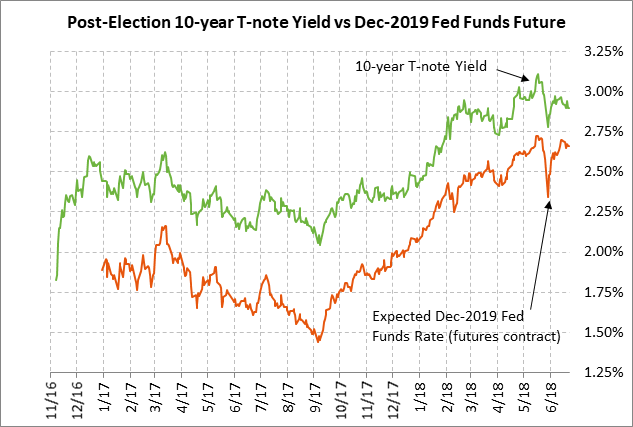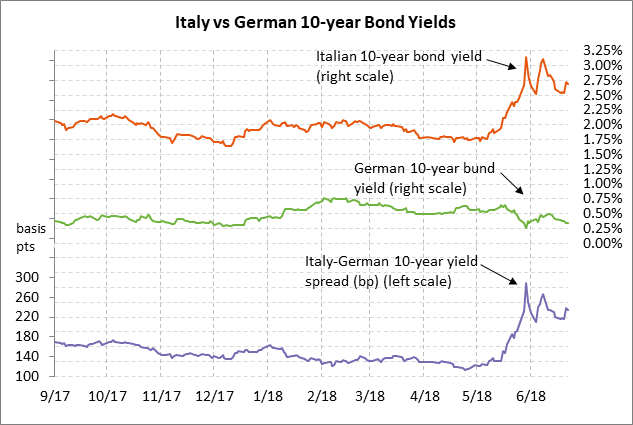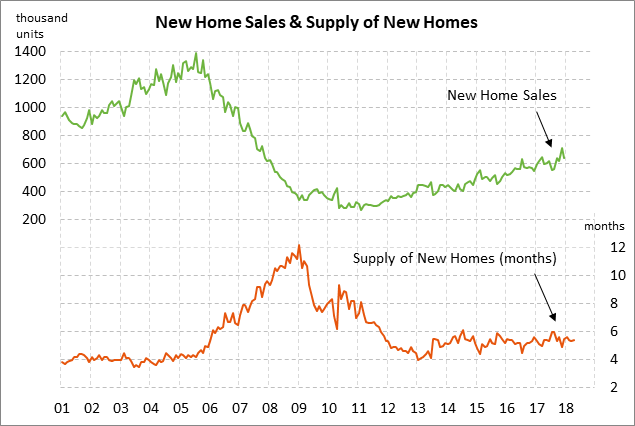- Weekly global market focus
- Merkel is still searching for a migration solution after weekend mini-summit fails to make progress
- Oil prices rally sharply on vague OPEC+ agreement
- U.S. new home sales expected to show a modest increase
Weekly global market focus — The U.S. markets this week will focus on (1) trade tensions with President Trump last Friday threatening to slap a 20% import tariff on European vehicles and with only 11 days left for a compromise to avert the 25% reciprocal tariff that is due to go into effect on July 6 on $34 billion worth of U.S. and Chinese goods, (2) the diminished prospects for a NAFTA deal as leftwing candidate Obrador is expected to easily win this coming Sunday’s Mexican president election, who will put up a bigger fight with President Trump on NAFTA, (3) oil prices after last Friday’s OPEC+ agreement sparked a sharp rally in oil prices, (4) the Treasury’s sale of $80 billion of T-notes on Tuesday through Thursday, (5) a light earnings week with 16 of the S&P 500 companies reporting (including NIKE, Walgreens, General Mills, Accenture, Carnival), and (6) a busy economic calendar capped by Friday’s PCE deflator (expected to edge higher to +2.2% y/y from April’s +2.0% and core to +1.9% from +1.8%).
The U.S. Treasury by this coming Saturday (June 30) is due to release the details of a new set of restrictions on Chinese investment in the U.S.
In Europe, the focus will mainly be on the EU Summit on Thursday and Friday (June 28-29). German Chancellor Merkel is dealing with a challenge to her coalition as she seeks new immigration policies to placate her CSU partner. Separately, European trade officials this week may be more specific about how they will retaliate if President Trump follows through on his threat of last Friday to slap a 20% tariff on imported European vehicles.
European economic data this week includes a series of confidence indicators and inflation data later in the week. Friday’s Eurozone June CPI is expected to edge higher to +2.0% y/y from May’s +1.9% but the core CPI is expected to edge lower to +1.0% y/y from May’s +1.1%. ECB policy is on hold with the QE program ending in Q4 and with the ECB pledging not to raise interest rates until at least summer 2019.
In Asia, the markets on Monday will react to the Chinese central bank’s announcement over the weekend of a 50 bp cut in its required reserve ratio (RRR) to free up about $108 billion of bank liquidity. The markets had been expecting that reserve ratio cut as a support measure after China’s Shanghai Composite index last Friday fell to a new 2-year low on the Trump administration’s trade threats. In addition, the yuan has fallen by -1.5% against the dollar in the past two weeks due to the trade threats and concern about stock market weakness and capital flight. The PBOC is expected to leave interest rates unchanged since it cannot afford to grease the skids for any further drop in the yuan.
Chinese economic data this week includes (1) Tuesday night’s May industrial profits report, and (2) Friday night’s PMI data (June manufacturing PMI expected -0.1 to 51.8 after May’s +0.5 to 51.9). This coming Sunday night’s June Caixin Chinese manufacturing PMI is expected to show a -0.1 point decline to 51.0 after May’s report of unchanged.
Merkel is still searching for a migration solution after weekend mini-summit fails to make progress — German Chancellor Merkel on Sunday expressed pessimism about reaching an overall EU solution on migration and said the focus will have to be on bilateral and trilateral agreements. Ms. Merkel did not seem to make much headway on finding a solution for asylum seekers that will satisfy her Interior Minister Horst Seehofer, who has threatened to go ahead with an asylum order in defiance of Ms. Merkel. That would likely get him fired and Mr. Seehofer, who is also the head of the CSU party, might then withdraw his party from the government and force new German elections. Ms. Merkel has a deadline of the EU Summit later this week to come up with some compromise that will satisfy Mr. Seehofer.
Oil prices rally sharply on vague OPEC+ agreement — Aug WTI crude oil prices last Friday rallied sharply by +4.64% after OPEC+ reached an agreement that may result in a production boost of about 600,000-700,000 bpd. OPEC+ agreed to a nominal production hike of 1.0 million bpd but that will translate into an actual production hike of only about two-thirds of that since most OPEC members do not have the capability to boost production. Friday’s agreement was essentially to just enforce 100% compliance with the original 1.8 million bpd production cut and do away with the unintentional additional cut of nearly 50%.
There was a wide variance in estimates for the amount of new production that is likely to result from Friday’s agreement. However, Saudi Arabia suggested it might boost production by 250,000 to 400,000 bpd, while Russia may boost production by 200,000 bpd.
U.S. new home sales expected to show a modest increase — The market consensus is for today’s May new home sales report to show an increase of +0.8% to 667,000, reversing about half of April’s -1.5% decline to 662,000. New home sales remain generally strong at only -7% below the 10-1/2 year high of 712,000 posted in Nov 2017. Existing home sales in May fell by -0.4% to 5.43 million units, which did not bode well for today’s new home sales report.
Demand for new homes remains strong due to (1) the strong economy and labor market, (2) strong consumer confidence, and (3) rising household income and wealth. However, headwinds for home sales include (1) high prices, (2) rising mortgage rates, and (3) tight supplies. There were 5.4 months worth of new homes on the market in April, which was below the long-term average of 6.1 months. The median price of a new home was $312,400 in April, which was 9% below the record high of $343,400 posted in Nov 2017.





